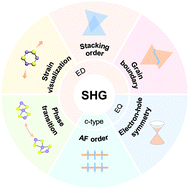Rich information on 2D materials revealed by optical second harmonic generation
Abstract
Two-dimensional (2D) materials have brought a spectacular revolution in fundamental research and industrial applications due to their unique physical properties of atomically thin thickness, strong light–matter interaction, unity valley polarization and enhanced many-body interactions. To fully explore their exotic physical properties and facilitate potential applications in electronics and optoelectronics, an effective and versatile characterization method is highly demanded. Among the many methods of characterization, optical second harmonic generation (SHG) has attracted broad attention because of its sensitivity, versatility and simplicity. The SHG technique is sufficiently sensitive at the atomic scale and therefore suitable for studies on 2D materials. More importantly, it has the capacity to acquire abundant information ranging from crystallographic, and electronic, to magnetic properties in various 2D materials due to its sensitivity to both spatial-inversion symmetry and time-reversal symmetry. These advantages accompanied by its characteristics of non-invasion and high throughput make SHG a powerful tool for 2D materials. This review summarizes recent experimental developments of SHG applications in 2D materials and also provides an outlook of potential prospects based on SHG.

- This article is part of the themed collection: Recent Review Articles


 Please wait while we load your content...
Please wait while we load your content...